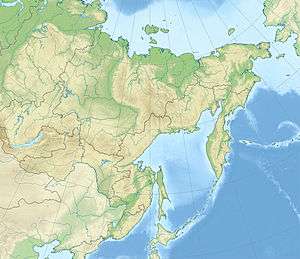1995 Neftegorsk earthquake
The 1995 Neftegorsk earthquake occurred on 28 May at 1:04 local time[5] on northern Sakhalin Island in the Russian Far East.[6] It was the most destructive earthquake known within the current territory of Russia,[7] with a magnitude of Ms7.1 and maximum Mercalli intensity of IX (Violent)[8] that devastated the oil town of Neftegorsk, where 2,040 of its 3,977 citizens were killed, and another 750 injured.[9]
 | |
| UTC time | 1995-05-27 13:03:53 |
|---|---|
| ISC event | 106336 |
| USGS-ANSS | ComCat |
| Local date | 27 May 1995 |
| Local time | 1:04 a.m. local time |
| Magnitude | Ms(HRV) 7.1 [1] |
| Depth | 11.0 km (7 mi) [2] |
| Epicenter | 52.63°N 142.83°E |
| Type | Strike-slip [3] |
| Areas affected | Sakhalin, Russian Far East |
| Total damage | $64.1–300 million [3] |
| Max. intensity | IX (Violent)[4] |
| Casualties | 1,989 dead [3] 750 injured [3] |
90% of the victims were killed by the collapse of 17 five-story residential buildings.[10] While Western media generally attributed the collapses to allegedly poor construction and shoddy materials of Soviet-era construction,[11] a geotechnical study faulted a failure to accommodate the possibility of soil liquefaction in an area that was considered "practically aseismic".[12]
The Belgian Centre for Research on the Epidemiology of Disasters' EM-DAT database places the total damage at $64.1 million, while the United States' National Geophysical Data Center assesses the damage at $300 million.[3]
This quake was not only catastrophic, it was totally unexpected: earthquakes with magnitudes greater than 6 were not known to occur in the area of northern Sakhalin Island.[13] It is also of great scientific interest (some 20 papers have been published[14]) because it occurred near a poorly known tectonic plate boundary where the Okhotsk Plate (connected with North American Plate) is crashing into the Amurian Plate (part of the Eurasian Plate),[15] and indicates that the plate boundary is associated with a north-south striking seismic belt that runs the length of Sakhalin. More precisely, this earthquake occurred on the Upper Piltoun fault (also known as the Gyrgylan'i—Ossoy fault[16]), which branches off the main Sakhalin-Hokkaido fault that runs along the east side of the island.[17]
35 km (22 mi) of surface rupturing was observed (46 km including a branching fault), with an estimated average lateral displacement of about 4 meters, but up to 8 m (9 yd) in some places.[18] (This compares to 14 km of slip estimated to have accumulated on the Sakhalin-Hokkaido fault in the last 4 million years.[19]) The unusual strength of this quake and length of rupturing, and the low level of seismic activity beforehand, has been attributed to the accumulation of strain over a long period of time on a locked fault segment.[20]
See also
Notes
- ISC-EB Event 106336 [IRIS] ANSS reports this as Mwb7.1.
- ISC-EHB Event 106336 [IRIS].
- USGS (September 4, 2009), PAGER-CAT Earthquake Catalog, Version 2008_06.1, United States Geological Survey
- ISC-EHB Event 106336 [IRIS].
- Klyachko 2001, p. 1.
- ANSS: Sakhalin 1995.
- Arefiev et al. 2000, p. 595.
- ISC-EHB Event 106336 [IRIS]. The ANSS: Sakhalin 1995 reviewed value on the Mwb scale is also 7.1. Some sources have reported the magnitude as Ms 7.6.
- Earth Chronicles (2016) attributes the fatality numbers to the Russian Ministry of Emergencies. The ISC, without citing a source, says "[a]s many as 1,989 people killed" (ISC-EHB Event 106336 [IRIS]). Other sources attribute the "more than 2000" number to Japanese language sources.
- Klyachko 2001, p. 1. These buildings housed all but about 650 of the town's residents. Los Angeles Times 1995
- Los Angeles Times 1995.
- Klyachko 2001, p. 2.
- Arefiev et al. 2000, pp. 595, 605.
- ISC-EB Event 106336 [IRIS].
- Arefiev et al. 2000, p. 595; Katsumata et al. 2004, pp. 117, 129.
- Katsumata et al. 2004, p. 117
- Arefiev et al. 2000, p. 596.
- Arefiev et al. 2000, p. 599.
- Arefiev et al. 2000, p. 596.
- Arefiev et al. 2000, p. 606.
Sources
- ANSS, "Sakhalin 1995", Comprehensive Catalog, U.S. Geological Survey .
- Arefiev, S.; Rogozhin, E.; Tatevossian, R.; Rivera, L.; Cisternas, A. (2000), "The Neftegorsk (Sakhalin Island) 1995 earthquake: a rare interplate event", Geophysical Journal International, 143 (3): 595–607, Bibcode:2000GeoJI.143..595A, doi:10.1046/j.1365-246x.2000.00234.x.
- Aref'ev, S. S.; Dorbath, K. (2001), "The 1995 Neftegorsk earthquake: Tomography of the source zone" (PDF), Izvestiya, Physics of the Solid Earth, 37 (2): 141–150.
- "Earthquake in Neftegorsk on May 28, 1995", The Earth Chronicles of Life, May 29, 2017.
- International Seismological Centre, Event Bibliography, Thatcham, United Kingdom, http://www.isc.ac.uk/ .
- International Seismological Centre, ISC-EHB Bulletin, Thatcham, United Kingdom, http://www.isc.ac.uk/ .
- Johnson, M. S. (1998), "The Tale of the Tragedy of Neftegorsk", Prehospital and Disaster Medicine, 13 (1): 67–72, doi:10.1017/S1049023X00033057, PMID 10187029.
- Katsumata, K.; Kasahara, M.; Ichiyanagi, M.; Kikuchi, M.; Sen, R.; Kim, C.; Ivaschenko, A.; Tatevossian, R. (February 2004), "The 27 May 1995 Ms 7.6 Northern Sakhalin Earthquake: An Earthquake on an Uncertain Plate Boundary" (PDF), Bulletin of the Seismological Society of America, 94 (1): 117–130, Bibcode:2004BuSSA..94..117K, doi:10.1785/0120020175.
- Klyachko, Mark A. (2001), "Geotechnical Lessons Learnt From Neftegorsk Earthquake", International Conferences on Recent Advances in Geotechnical Earthquake Engineering and Soil Dynamics, 9, Paper No. 10.21.
- Efron, Sonni (May 29, 1995), "7.5 Quake Kills 300 on Russia's Sakhalin Island", Los Angeles Times.
External links
- 7.5 Quake Kills 300 on Russia's Sakhalin Island – Los Angeles Times
- Earth Chronicles has dramatic pictures of the devastation in Neftegorsk.
- The Sakhalin earthquake of May 27, 1995 – Earthquake Engineering Research Institute
- The International Seismological Centre has a bibliography and/or authoritative data for this event.